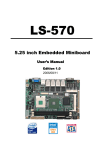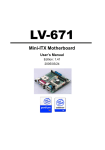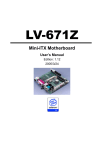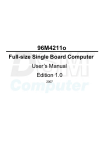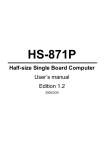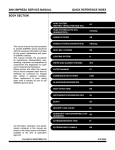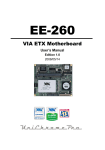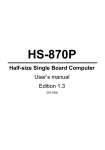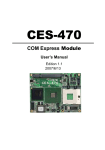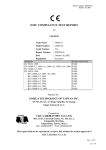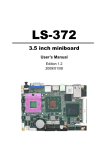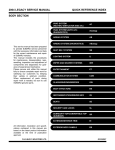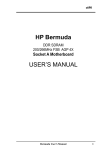Download LE-370/LE-370Z
Transcript
LE-370/LE-370Z 3.5 Inches Embedded Miniboard User’s Manual Edition: 1.0 2005/3/23 LE-370 User’s Manual Copyright Copyright 2004 - 2005. All rights reserved. This document is copyrighted and all rights are reserved. The information in this document is subject to change without prior notice to make improvements to the products. This document contains proprietary information and protected by copyright. No part of this document may be reproduced, copied, or translated in any form or any means without prior written permission of the manufacturer. All trademarks and/or registered trademarks contains in this document are property of their respective owners. Disclaimer The company shall not be liable for any incidental or consequential damages resulting from the performance or use of this product. The company does not issue a warranty of any kind, express or implied, including without limitation implied warranties of merchantability or fitness for a particular purpose. The company has the right to revise the manual or include changes in the specifications of the product described within it at any time without notice and without obligation to notify any person of such revision or changes. Trademark All trademarks are the property of their respective holders. Any questions please visit our website at http://www.commell.com.tw TU 2 UT LE-370 User’s Manual Packing List: Please check the package before you starting setup the system Hardware: LE-370/LE-370Z motherboard x 1 Cable Kit: 44-pin 40-pin 44-pin 44-pin ATA33 IDE Cable x 1 CPU Cooler (LE-370 only) COM port & Printer Port Cable x 1 USB Cable x 1 PS/2 keyboard & mouse cable x 1 Floppy Cable x 1 Audio Cable x 1 1 to 3 power output cable Other Accessories: Divers CD (including User’s Manual) x 1 Printed User’s Manual x 1 Packing List 3 LE-370 User’s Manual Index Chapter 1 <Introduction> .................................................................................. 7 1.1 <Product Overview>.............................................................................. 7 1.2 <Product Specification> ........................................................................ 8 1.3 <Mechanical Drawing>........................................................................ 10 1.4 <Block Diagram>................................................................................. 11 Chapter 2 <Hardware Setup>.......................................................................... 13 2.1 <Connector Location>......................................................................... 13 2.2 <Jumper Location & Reference> ........................................................ 14 2.3 <Connector Reference>...................................................................... 15 2.3.1 <Internal Connector>............................................................... 15 2.3.2 <External Connector>.............................................................. 15 2.4 <CPU & Memory Setup>..................................................................... 16 2.4.1 <CPU>..................................................................................... 16 2.4.2 <Memory> ............................................................................... 17 2.4.3 <CPU Cooler Installation>....................................................... 18 2.5 <CMOS Setup> ................................................................................... 19 2.6 <Enhanced IDE & CF interface>......................................................... 20 2.7 <Floppy Port>...................................................................................... 21 2.8 <Ethernet Interface> ........................................................................... 22 2.9 <Onboard Display Interface> .............................................................. 23 2.9.1 <Analog Display Interface> ..................................................... 23 2.9.2 <Digital Display Interface>....................................................... 24 2.10 <Onboard Audio Interface>............................................................... 28 2.11 <GPIO Interface> .............................................................................. 29 2.12 <Power Supply & Fan> ..................................................................... 30 2.12.1 <Power Input> ....................................................................... 30 2.12.2 <Power Output> .................................................................... 30 2.12.3 <Fan connectors>.................................................................. 30 4 LE-370 User’s Manual 2.13 <Switch & Indicator> ......................................................................... 31 Chapter 3 <System Setup> ............................................................................. 33 3.1 <Display Configuration>...................................................................... 33 Chapter 4 <BIOS Setup> ................................................................................. 35 Appendix A <I/O Port Pin Assignment>......................................................... 37 A.1 <IDE Port> .......................................................................................... 37 A.2 <Floppy Port> ..................................................................................... 38 A.3 <IrDA Port> ......................................................................................... 38 A.4 < VGA Port >....................................................................................... 38 A.5 <Serial Port>....................................................................................... 39 A.6 <LAN Port> ......................................................................................... 39 A.7 <PS/2 Keyboard & Mouse Port> ........................................................ 39 Appendix B <Flash BIOS> .............................................................................. 41 B.1 BIOS Auto Flash Tool ................................................................... 41 B.2 Flash Method ............................................................................... 41 Appendix C <Hardware Test> ......................................................................... 43 C.1 <Power Consumption Test> ............................................................... 43 Contact Information......................................................................................... 44 Packing List 5 LE-370 User’s Manual (This Page is Left For Blank) 6 LE-370 User’s Manual Introduction Chapter 1 <Introduction> 1.1 <Product Overview> LE-370/LE-370Z are the 3.5 inches embedded miniboards based on Intel 852GME/GM of platform, with Intel Pentium M/Celeron M processors supported, onboard VGA, LAN, Audio, USB2.0, CF, LVDS, and mini-PCI to meet the variable applications of users. LE-370Z with onboard Intel Celeron M processor for ultra low power can offer the fanless solution for such as medical applications. Intel 852GME/GM & ICH4 Chipset The board integrates Intel 852GME/GM and ICH4 chipset, to provide built-in Intel Extreme Graphics Technology, and supports DDR200/266/333 memory up to 1G of capacity. 18/24-bit LVDS LCD interface The board provides onboard 18/24-bit LVDS LCD interface, supports up to 1600 x 1200 of UXGA high resolution for LE-370, and up to 1400 x 1050 for LE-370Z. Flexible Extension Interfaces The board provides one Mini-PCI socket for wireless LAN module, video capture card and IEEE1394 add-on card. The board also provide optional PCI interface with a riser card to have up to 2 PCI devices. Product Overview 7 LE-370 User’s Manual Introduction 1.2 <Product Specification> General Specification LE-370 Form Factor CPU Memory Chipset BIOS Green Function Watchdog Timer Real Time Clock Enhanced IDE LE-370Z 3.5 inches Embedded Miniboard Embedded Intel Celeron M Intel Pentium M/Celeron M Ratio: 600MHz Package: FC-PGA478 FSB: 400MHz FSB: 400/533MHz 1 x 184-pin DDR 200/266 1 x 184-pin DDR 266/333 SDRAM up to 1GB SDRAM up to 1GB Non-ECC supported ECC memory supported Intel 852GME and ICH4 Intel 852GM and ICH4 Phoenix-Award v6.00PG 4Mb PnP flash BIOS Power saving mode includes doze, standby and suspend modes. ACPI version 1.0 and APM version 1.2 compliant System reset programmable watchdog timer with 1 ~ 255 sec./min. of timeout value Intel ICH4 built-in RTC with lithium battery Enhanced UltraDMA100 IDE interface supports dual channels and up to 2 ATAPI devices One 44-pin IDE connector onboard Multi-I/O Port Chipset Serial Port USB Port Parallel Port Floppy Port IrDA Port K/B & Mouse GPIO Hardware Monitor Winbond W83627HF-AW controller One external & one internal RS-232 serial ports Two Hi-Speed USB 2.0 ports with 480Mbps of transfer rate One bi-direction parallel port with SPP/ECP/EPP mode One slim type Floppy port One IrDA compliant Infrared interface supports SIR External PS/2 keyboard and mouse ports on rear I/O panel One 8-bit programmable GPIO interface Fan speed, CPU temperature and voltage monitoring VGA Display Interface Chipset Frame Buffer Display Type Connector Intel 852GME/GM built-in Intel Extreme graphics Intel DVMT with up to 64MB of frame buffer size CRT, LCD monitor with analog display External DB15 female connector on rear I/O panel LCD Interface Chipset Interface 8 Intel 852GME/GM built-in LVDS interface 18/24-bit LVDS interface 12V backlight inverter connector Product Specification LE-370 User’s Manual Introduction Ethernet Interface Controller Type Connector Intel 82562ET PHY 10Base-T / 100Base-TX auto-switching Fast Ethernet Full duplex, IEEE802.3U compliant External RJ45 connectors with LED on rear I/O panel Audio Interface Chipset Interface Connector REALTEK ALC201A 2 channel 3D audio with Line-in, Line-out and MIC-in External Audio phone jack for Line-out Onboard audio connector with pin header Onboard CD-IN connector Expansive Interface Mini-PCI PCI Solid State Disk DOM CompactFlash 1 x 32-bit 5V/3.3V Mini-PCI socket 1 x optional PCI interface supports up to two PCI devices through riser card IDE1 supports 44-pin DOM (DiskOnModule) 1 x CompactFlash Type 1 socket on solder side Power and Environment Power Requirement Dimension Temperature DC 12V input 1 x DC jack on I/O panel or 1 x 4-pin DC connector onboard 154 (L) x 101 (H) mm Operating within 0 ~ 60oC (32 ~ 140oF) Storage within -20 ~ 85oC (-4 ~ 185oF) P P P P P P P P Software support Operation System Windows 98SE/ME, Windows 2000, Windows XP Linux (Fedora Core 1, Mandrake 9.2 and Red Hat 9.0) Linux Kernel version 2.4 or later Ordering Code LE-370 Intel Pentium M/Celeron M with socket479, VGA, AC97 Audio, LVDS, CF, PCI, Mini-PCI, 2 x RS232, LAN, LE-370Z Same with above but with onboard Intel Celeron M 600 processor 1. The specifications may be different as the actual production. For further product information please visit the website at http://www.commell.com.tw TU Product Specification UT 9 LE-370 User’s Manual Introduction 1.3 <Mechanical Drawing> 10 Mechanical Drawing LE-370 User’s Manual Introduction 1.4 <Block Diagram> Intel Pentium M processor with FC-PGA2/FC-BGA2 CRT/LCD Monitor LVDS 1 x 184-pin DDR DIMM up to 1GB 852GME/GM 2 x USB2.0 Ports PCI 82562ET PHY ICH4 AC97 Codec Mini-PCI 2 x Serial ports 1 x Floppy ports BIOS 8-bit GPIO IrDA 1 x Parallel port Block Diagram 11 LE-370 User’s Manual (This Page is Left for Blank) 12 LE-370 User’s Manual Hardware Setup Chapter 2 <Hardware Setup> 2.1 <Connector Location> CN_COM2 AUDIO COM1 CDIN CRT CN_INV RJ45 PS2 DC_IN CN_12V CN_USB CN_AUDIO CN_DIO CN_SPWR LPT CPUFAN CN_LVDS SYSFAN MINIPCI DIMM CN_IR IDE1 JFRNT FDD CF Connector Location 13 LE-370 User’s Manual Hardware Setup 2.2 <Jumper Location & Reference> Jumper JRTC JVLCD Function CMOS Operating/Clear Setting LCD panel voltage setting JVLCD JRTC 14 Jumper Location & Reference LE-370 User’s Manual Hardware Setup 2.3 <Connector Reference> 2.3.1 <Internal Connector> Connector DIMM IDE1 FDD CN_12V CDIN CN_DIO CN_USB CPUFAN SYSFAN CN_COM2 CN_IR CF MINI_PCI CN_LVDS CN_INV LPT JFRNT CN_SPWR Function 184-pin DDR SDRAM DIMM 44-pin primary IDE connector 26-pin slim type floppy connector 4-pin DC input connector 4-pin CD-ROM audio input connector 6 x 2-pin digital I/O connector 5 x 2-pin USB connector 3-pin CPU cooler fan connector 3-pin system cooler fan connector 5 x 2-pin RS232 serial port 5-pin IrDA connector Compact Flash Type I socket Mini-PCI interface 40-pin LVDS LCD interface 5-pin LCD backlight inverter connector 26-pin parallel port interface 14-pin front panel switch/indicator connector 4-pin DC 5V/12V output connector Remark Standard Standard Standard Standard Standard Standard Standard Standard Standard Standard Standard Standard Standard Standard Standard Standard Standard Standard 2.3.2 <External Connector> Connector CRT RJ45 COM1 PS2 Audio DC_IN Function DB15 VGA connector RJ45 LAN connector Serial port connector PS/2 Keyboard/Mouse connector Audio Line-out port DC input jack Connector Reference Remark Standard Standard Standard Standard Standard Standard 15 LE-370 User’s Manual Hardware Setup 2.4 <CPU & Memory Setup> 2.4.1 <CPU> LE-370 supports onboard socket479 for Intel Pentium M/Celeron M processors with FC-PGA478 package, 400/533MHz of front side bus; LE-370Z integrates onboard Intel Celeron M 600MHz processor with 400MHz of front side bus. For LE-370 please follow the instruction to install the CPU properly. CPU Socket 1. Use flat-type Screw Driver to 2. Find the pin direction and unlock the CPU locket install the processor on the socket. CPU locker Unlock way 3. Lock the socket well. 16 CPU & Memory Setup LE-370 User’s Manual Hardware Setup 2.4.2 <Memory> LE-370 supports DDR266/333 up to 1GB with ECC; LE-370Z supports DDR200/266 up to 1GB with unbuffered, non-ECC memory module. DIMM 104-pin 80-pin Please check the pin number to match the socket side well before installing memory module. CPU & Memory Setup 17 LE-370 User’s Manual Hardware Setup 2.4.3 <CPU Cooler Installation> The LE-370 provides one CPU cooler; please follow the instruction below to finish the installation. The LE-370Z comes with a heat sink on embedded processor, no fan is required. 1. Install CPU properly 2. Put the cooler on the socket 3. Press the clips into the through hole 4. Connect with CPUFAN connector 18 CPU & Memory Setup LE-370 User’s Manual Hardware Setup 2.5 <CMOS Setup> The board’s data of CMOS can be setting in BIOS. If the board refuses to boot due to inappropriate CMOS settings, here is how to proceed to clear (reset) the CMOS to its default values. Jumper: JRTC Type: Onboard 3-pin jumper JRTC 1-2 2-3 Default setting Mode Clear CMOS Normal Operation JRTC 3 1 CMOS Setup 19 LE-370 User’s Manual Hardware Setup 2.6 <Enhanced IDE & CF interface> The board supports one UltraDMA133 IDE interface, and one CompactFlash Type 1 socket with secondary IDE mode, the 44-pin IDE1 connector can support up to 2 ATAPI devices through IDE cable. 2 44 1 43 IDE1 CF 20 Enhanced IDE & CF Interface LE-370 User’s Manual Hardware Setup 2.7 <Floppy Port> The board provides a slim type floppy port; please use the 26-pin ribbon cable in the package to connect the floppy device. FDD 1. Floppy rear side Floppy Port Lift up the brown plastic bar 2. Slot the cable in (Blue paste for 3. brown bar side) Press back the plastic bar 4. Lift up this plastic bar 5. Slot the cable in (Blue paste for outside) 6. Press back the plastic bar 21 LE-370 User’s Manual Hardware Setup 2.8 <Ethernet Interface> The board integrates Ethernet controller with Intel 82562ET PHY, full compliance with IEEE 802.3u 100Base-T specifications and IEEE 802.3x Full Duplex Flow Control, the board supports Wake-Up-On-LAN by BIOS configurable. RJ45 For Wake Up On LAN function, please enable this option in the BIOS 22 Ethernet Interface LE-370 User’s Manual Hardware Setup 2.9 <Onboard Display Interface> Based on Intel 852GME/GM chipset with built-in Intel Extreme Graphics, the board provides onboard VGA display interface, and one 18/24-bit LVDS LCD interface, supports up to 1600 x 1200 of resolution for LE-370 (with 852GME) and 1400 x 1050 for LE-370Z (with 852GM). The two display interfaces can be set for dual display with extended desktop mode or clone mode. Below are the main features lists: 128-bit 2D/3D graphics engine Up to 64MB of dynamic video memory allocation. Hardware Motion Compensation for MPEGII Dual display supported for Clone mode and Extended Desktop mode 2.9.1 <Analog Display Interface> The onboard VGA display comes with standard DB15 connector on real I/O panel. CRT (Analog Display Interface) Onboard Display Interface 23 LE-370 User’s Manual Hardware Setup 2.9.2 <Digital Display Interface> The onboard digital display interface comes with a 40-pin header connector to provide 18/24-bit LVDS LCD interface, and one backlight inverter connector for powering and enable/disable control, the jumper JVLCD is to set the panel voltage. 1 JVLCD 24 3 40 2 39 1 CN_INV 5 CN_LVDS 1 Onboard Display Interface LE-370 User’s Manual Hardware Setup Connector: CN_INV Type: 5-pin LVDS Power Header Pin 1 2 3 4 5 Description +12V GND GND GND ENABKL Connector: JVLCD Type: 3-pin Power select Header Pin 1 2 3 Description VCC LCDVCC VCC3 Connector: CN_LVDS Type: onboard 40-pin connector for LVDS connector Connector model: HIROSE DF13-40S Pin 1 3 5 7 9 11 13 15 17 19 21 23 25 27 29 31 33 35 37 39 Onboard Display Interface Signal LCDVCC GND ATX0ATX0+ GND ATX1ATX1+ GND ATX2ATX2+ GND ATX3ATX3+ GND ATXCKATXCK+ GND N/C N/C N/C Pin 2 4 6 8 10 12 14 16 18 20 22 24 26 28 30 32 34 36 38 40 Signal LCDVCC GND BTX0BTX0+ GND BTX1BTX1+ GND BTX2BTX2+ GND BTXCKBTXCK+ GND BTX3BTX3+ GND N/C N/C N/C 25 LE-370 User’s Manual Hardware Setup To setup the LCD, you need the component below: 1. A panel with LVDS interfaces. 2. An inverter for panel’s backlight power. 3. A LCD cable and an inverter cable. For the cables, please follow the pin assignment of the connector to make a cable, because every panel has its own pin assignment, so we do not provide a standard cable; please find a local cable manufacture to make cables. LCD Installation Guide: 1. Preparing the LE-370, LCD panel and the backlight inverter. 2. Please check the datasheet of the panel to see the voltage of the panel, and set the jumper JVOLT to +5V or +3.3V. 3. You would need a LVDS type cable. Panel side Board side For sample illustrator only 4. 26 To connect all of the devices well. Onboard Display Interface LE-370 User’s Manual Hardware Setup After setup the devices well, you need to select the LCD panel type in the BIOS. The panel type mapping is list below: BIOS panel type selection form For 18-bit color For 24-bit color NO. Output format NO. Output format 1 640 x 480 8 1024 x 768 2 800 x 600 9 1280 x 1024 Dual Channel 3 1024 x 768 10 1400 x 1050 Dual Channel 4 1280 x 1024 11 1600 x 1200 Dual Channel 5 1400 x 1050 Dual Channel @ 108Mhz 13 1024 x 768 Dual Channel 6 1400 x 1050 Dual Channel @ 122Mhz 14 1920 x 1080 Dual Channel 7 1600 x 1200 Dual Channel 15 1280 x 768 12 1024 x 768 Dual Channel Notice: Panel type 7, 11 and 14 are only supported by LE-370, not for LE-370Z Onboard Display Interface 27 LE-370 User’s Manual Hardware Setup 2.10 <Onboard Audio Interface> The board integrates onboard AC97 audio with REALTEK ALC201A, supports 18-bit ADC and DAC resolution, and Line-out, Line-in and MIC-in input/output interfaces. Connector: CN_AUDIO Type: 10-pin (2 x 5) 1.27mm x 2.54mm-pitch header Pin Description Pin Description 1 Line – Left 2 Ground 3 Line – Right 4 MIC1 5 MIC2 6 Ground 7 N/C 8 Line Out – Left 9 Line Out – Right 10 Ground Connector: CDIN Type: 4-pin header (pitch = 2.54mm) Pin Description 1 CD – Left 2 Ground 3 Ground 4 CD – Right CDIN Audio (Line-out) 1 2 9 10 1 4 CN_AUDIO 28 Onboard Audio Interface LE-370 User’s Manual Hardware Setup 2.11 <GPIO Interface> The board offers 8-bit digital I/O to customize its configuration to your control needs. For example, you may configure the digital I/O to control the opening and closing of the cash drawer or to sense the warning signal from a tripped UPS. Connector: CN_DIO Type: onboard 2 x 6-pin 1.27mm x 2.54mm-pitch header Pin Description Pin Description 1 Ground 2 Ground 3 LGP0 4 LGP4 5 LGP1 6 LGP5 7 LGP2 8 LGP6 9 LGP3 10 LGP7 11 VCC 12 +12V 1 2 12 11 CN_DIO GPIO Interface 29 LE-370 User’s Manual Hardware Setup 2.12 <Power Supply & Fan> 2.12.1 <Power Input> The board requires DC 12V input with onboard DC jack or 4-pin 12V DC connector. Connector: CN_12V Type: 4-pin standard ATX2.0 +12V power connector Pin Description Pin Description 1 Ground 2 Ground 3 +12V 4 +12V 2.12.2 <Power Output> The board also provides one 4-pin connector with +5V/+12V output. Connector: CN_SPWR Type: 4-pin P-type connector for +5V/+12V output Pin Description Pin Description Pin Description 1 +12V 2 Ground 3 Ground Pin 4 Description +5V PS: Maximum output current for 5V/1A & 12V/1A 2.12.3 <Fan connectors> Connector: CPUFAN, SYSFAN Type: 3-pin fan wafer connector Pin Description Pin 1 Ground 2 Description +12V Pin 3 Description Fan Control DC_IN CN_12V 4 3 2 1 1 4 CN_SPWR 3 1 SYSFAN/CPUFAN 30 Power Supply & Fan LE-370 User’s Manual Hardware Setup 2.13 <Switch & Indicator> The JFRNT provides front control panel of the board, such as power button, reset and beeper, etc. Please check well before you connecting the cables on the chassis. Connector: JFRNT Type: onboard 14-pin (2 x 7) 2.54-pitch header Function Signal PIN Signal VCC 1 2 VCC Active 3 4 N/C Reset 5 6 GND GND 7 8 VCC N/C 9 10 N/C Power PWRBT 11 12 N/C Button 5VSB 13 14 SPKIN IDE LED Function Power LED Reset Speaker 14 JFRNT 1 Switch & Indicator 31 LE-370 User’s Manual (This Page is Left for Blank) 32 LE-370 User’s Manual System Setup Chapter 3 <System Setup> 3.1 <Display Configuration> The board provides onboard VGA with DB15 analog display interface, and LVDS LCD interface for digital display, when connecting two display devices, you can enable dual display function with clone mode or extended desktop mode. Before setup the video setting, please install the VGA driver well. Two controllers for each display device There are two options for secondary display device For more display properties setting, please click “Advanced” button. Click here for more details of display setup Display Configuration 33 LE-370 User’s Manual System Setup Please select Devices for advanced device setting. Single Display Device Setting Dual Display Device Setting When you set dual display clone mode, you’ll see the same screen display on two devices. When you set the dual display for extended desktop mode, you can have the independent desktop on the second device. 34 Display Configuration LE-370 User’s Manual BIOS Setup Chapter 4 <BIOS Setup> The single board computer uses the Award BIOS for the system configuration. The Award BIOS in the single board computer is a customized version of the industrial standard BIOS for IBM PC AT-compatible computers. It supports Intel x86 and compatible CPU architecture based processors and computers. The BIOS provides critical low-level support for the system central processing, memory and I/O sub-systems. The BIOS setup program of the single board computer let the customers modify the basic configuration setting. The settings are stored in a dedicated battery-backed memory, NVRAM, retains the information when the power is turned off. If the battery runs out of the power, then the settings of BIOS will come back to the default setting. The BIOS section of the manual is subject to change without notice and is provided here for reference purpose only. The settings and configurations of the BIOS are current at the time of print, and therefore they may not be exactly the same as that displayed on your screen. To activate CMOS Setup program, press <DEL> key immediately after you turn on the system. The following message “Press DEL to enter SETUP” should appear in the lower left hand corner of your screen. When you enter the CMOS Setup Utility, the Main Menu will be displayed as Figure 3-1. You can use arrow keys to select your function, press <Enter> key to accept the selection and enter the sub-menu. Figure 3-1. CMOS Setup Utility Main Screen BIOS Setup 35 LE-370 User’s Manual (This Page is Left for Blank) 36 LE-370 User’s Manual I/O Port Pin Assignment Appendix A <I/O Port Pin Assignment> A.1 <IDE Port> Connector: IDE1 Type: 44-pin (22 x 2) box header Pin 1 3 5 7 9 11 13 15 17 19 21 23 25 27 29 31 33 35 37 39 41 43 IDE Port Description Reset D7 D6 D5 D4 D3 D2 D1 D0 Ground REQ -IOW -IOR IORDY DACK IRQ14 A1 A0 -CS1 -HD LED1 +5V Ground Pin 2 4 6 8 10 12 14 16 18 20 22 24 26 28 30 32 34 36 38 40 42 44 2 44 1 43 Description Ground D8 D9 D10 D11 D12 D13 D14 D15 N/C Ground Ground Ground Ground Ground N/C GPI1 A2 -CS3 Ground +5V Ground 37 LE-370 User’s Manual I/O Port Pin Assignment A.2 <Floppy Port> Connector: FDD Type: 26-pin connector Pin Description 1 VCC 3 VCC 5 VCC 7 DRV1 9 MTR1 11 RPM 13 N/C 15 Ground 17 Ground 19 N/C 21 N/C 23 Ground 25 Ground Pin 2 4 6 8 10 12 14 16 18 20 22 24 26 Description INDEX DRV0 DSKCHG N/C MTR0 DIR STEP WRITE DATA WRITE GATE TRACK 0 WRPTR RDATASEL A.3 <IrDA Port> 5 Connector: CN_IR Type: 5-pin header for SIR Ports Pin Description 1 VCC 2 N/C 3 IRRX 4 Ground 5 IRTX 6 A.4 < VGA Port > Connector: CRT Type: 15-pin D-sub female connector on bracket Pin Description Pin Description 1 RED 6 Ground 2 GREEN 7 Ground 3 BLUE 8 Ground 4 N/C 9 N/C 5 Ground 10 Ground 38 1 1 2 3 4 5 12 13 14 10 Pin 11 12 13 14 15 11 15 Description N/C 5VSDA HSYNC VSYNC 5VSCL Floppy Port LE-370 User’s Manual I/O Port Pin Assignment A.5 <Serial Port> Connector: COM1 Type: 9-pin D-sub male connector on bracket Pin Description Pin 1 DCD 6 2 RXD 7 3 TXD 8 4 DTR 9 5 Ground 1 2 3 4 5 6 7 8 9 Description DSR RTS CTS -XR 1 2 9 10 Connector: CN_COM2 Type: 10-pin (2 x 5) 1.27mm x 2.54mm-pitch header Pin Description Pin Description 1 DCD 2 3 RXD 4 RTS 5 TXD 6 CTS 7 DTR 8 -XR 9 Ground 10 A.6 <LAN Port> 1 Connector: RJ45 Type: RJ45 connector with LED on bracket Pin Description 1 TX+ 2 TX- 3 RX+ 4 RX- 8 5 N/C A.7 <PS/2 Keyboard & Mouse Port> 1 KBD 2 MSD 3 Ground 7 N/C 1 Connector: PS2 Type: 6-pin Mini-DIN connector on bracket Pin Description 6 N/C 2 4 VCC 5 KBC 8 N/C 3 5 6 4 6 MSC Note: The PS/2 connector supports standard PS/2 keyboard directly or both PS/2 keyboard and mouse through the PS/2 Y-type cable. Serial Port 39 LE-370 User’s Manual (This Page is Left for Blank) 40 LE-370 User’s Manual Flash BIOS Appendix B <Flash BIOS> B.1 BIOS Auto Flash Tool The board is based on Award BIOS and can be updated easily by the BIOS auto flash tool. You can download the tool online at the address below: http://www.award.com http://www.commell.com.tw/support/support.htm File name of the tool is “awdflash.exe”, it’s the utility that can write the data into the BIOS flash ship and update the BIOS. B.2 Flash Method 1. Please make a bootable floppy disk. 2. Get the last .bin files you want to update and copy it into the disk. 3. Copy awardflash.exe to the disk. 4. Power on the system and flash the BIOS. (Example: C:/ awardflash XXX.bin) 5. Re-star the system. Any question about the BIOS re-flash please contact your distributors or visit the web-site at below: http://www.commell.com.tw/support/support.htm Flash BIOS 41 LE-370 User’s Manual (This Page is Left for Blank) 42 LE-370 User’s Manual Hardware Test Appendix C <Hardware Test> C.1 <Power Consumption Test> Hardware Board CPU Memory HDD CDROM Power Supply LE-370Z Intel® Celeron® M 600MHz Infineon DDR333 512MB x1 Hitachi IC25N080ATMR04 80GB SDR-038 4x DVD-ROM SEVENTEAM ST-402HLP (not counted) Software OS Application Windows XP SP1 English Version 3DMARK 2003 Test Result Without LCD panel With 10.4” LCD panel With 15” LCD panel With 17” LCD panel Flash BIOS 24W 30W 38.4W 50W 43 LE-370 User’s Manual Contact Information Any advice or comment about our products and service, or anything we can help you please don’t hesitate to contact with us. We will do our best to support you for your p Taiwan Commate Computer Inc. Address 8F, No. 94, Sec. 1, Shin Tai Wu Rd., Shi Chih Taipei Hsien, Taiwan TEL +886-2-26963909 FAX +886-2-26963911 Website http://www.commell.com.tw UT E-Mail TU [email protected] (General Information) TU UT [email protected] (Technical Support) TU UT Commell is our trademark of industrial PC division 44













































